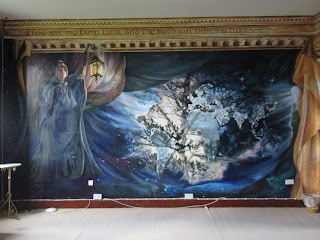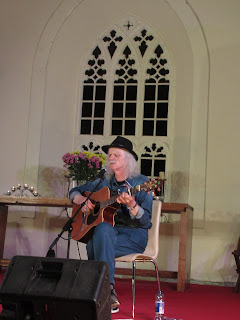We'd already tried twice without success to see the Harry Clarke stained-glass windows in Dingle's former Presentation Sisters' convent so were delighted to find the doors open the third time! This photo was of our first attempt to see the windows the day before. The abbey was now the home of the Institute of Education and Celtic Culture.
Before heading to the chapel we were directed to the recently painted Last Supper by our own Colorado artist Eleanor Yates. The fresco was appropriately painted in the Sister's dining room and depicted the moment in theological history when Jesus consecrated and then broke the bread for the remaining eleven Apostles.
Yates' commissioned work was permeated with local images, scenes and art forms with the Apostles all men she had found throughout Dingle.
The glasses, pitcher and vase in the painting were all crafted by local artisans. The golden chalice was was modeled after the famous Ardaugh chalice. The Harry Clarke windows from the upstairs chapel were shown on the left hand side of the fresco as was one of the Blasket Islands.
It was almost anti-climatic finally entering the chapel and viewing the Harry Clarke-designed windows by the renowned Dublin-born stained-glass artist. The windows behind the altar were Victorian but we'd come to see the chapel's side windows commissioned by Mother Superior Ita Macken in 1922. They were 'fitted' in 1924 at a cost of one thousand pounds.
Yes, Clarke's windows were lovely but for Rick Steves to award them 'two stars' out of a maximum of three stars seemed excessive to me. Steven and I have been fortunate seeing world class churches in any number of places with those having spectacular stained-glass windows of course. I am ready to claim ignorance but I failed to understand why these Harry Clarke windows were deserving of such special attention. Was Steves 'looking' for something of particular merit in tiny Dingle that he relaxed his normally high standards of what commands attention, I wondered?
The lower sections of the sanctuary's tiled walls were decorated with 24 marble panels adorned with special symbols: the acorn, the crown of thorns, nails, a Celtic cross, etc in memory of the builders. I thought the marble panels to be at least equally beautiful as the windows.
After witnessing poor, uneducated children in France, she returned to Ireland to open up a 'hedge school' or secret school for poor children which was illustrated here.
She sang two children's songs, one about a nest of ducklings, not of love and heartbreak!
His command of the pipes was one of the highlights of the evening.
Brown joked in between songs that polkas are a great way of exercising and much better than running around. Plus, he said, it's what we do here to keep fit as well as meeting people.
The Apostle on the right staring at us was the doubting Apostle. Judas has left in a hurry as shown by his upturned chair on the ground.
It was almost anti-climatic finally entering the chapel and viewing the Harry Clarke-designed windows by the renowned Dublin-born stained-glass artist. The windows behind the altar were Victorian but we'd come to see the chapel's side windows commissioned by Mother Superior Ita Macken in 1922. They were 'fitted' in 1924 at a cost of one thousand pounds.
Clarke's beautifully crafted windows illustrated the life of Christ from His birth and the Visit of the Magi up until the Resurrection when Jesus appeared to Mary Magdalene.
Yes, Clarke's windows were lovely but for Rick Steves to award them 'two stars' out of a maximum of three stars seemed excessive to me. Steven and I have been fortunate seeing world class churches in any number of places with those having spectacular stained-glass windows of course. I am ready to claim ignorance but I failed to understand why these Harry Clarke windows were deserving of such special attention. Was Steves 'looking' for something of particular merit in tiny Dingle that he relaxed his normally high standards of what commands attention, I wondered?
The Italian Carrara marble altar was dedicated to the Sacred Heart after the chapel's name.
The nuns' pews and chair stalls were hand-carved from Spanish oak; the arches of the stalls were mounted with the oak leaves and acorn symbols of the Presentation Order.
We saw another large mural also by Eleanor Yates in the Nano Nagle Room but it wasn't until I began writing this post that I knew who Nagle was as all the information we read at the abbey was about the painting as if we should have known who Nagle was. I googled her and found out she founded, in 1785, the Presentation Sisters, a teaching order that spans the globe. The first school they opened outside of Ireland was in far-off Newfoundland, in my native Canada. They were invited by an Irish Franciscan who wanted them to provide a good Catholic education for the women who worked in the fishing industry so that they might become “become mothers capable of teaching their children integrity and morality."
Part of the mural depicted Nagle's castle where she was born in County Cork. Another section showed her coming home after an all night ball in Paris where she had been sent as Catholic education in Ireland was outlawed under the British penal laws.
After witnessing poor, uneducated children in France, she returned to Ireland to open up a 'hedge school' or secret school for poor children which was illustrated here.
Another mural in the room showed Nano as the Lady of the Lamp attending the poor and the sick, young and old. I read that the cause for her beatification was in progress. Although I didn't think the Harry Clarke windows themselves merited our three attempts to see them, I was very glad we also had the opportunity to see the frescoes and murals by Yates as they helped bring the abbey to life for me.
That evening we returned for an Irish traditional music concert held at St. James Church, the same church we'd seen just the day before after arriving in town. The humble church was the home venue of the acclaimed "Other Voices" winter concert TV series that has drawn the late Amy Winehouse, Sinead O'Connor among other stars.
The church's altar became a concert venue with several musicians taking turns playing. One of them, Eoin Duignan, acted as the emcee and mentioned how he came down to Dingle back in 1979 to visit a young lady and never left!
Then, there was only one public house or bar, O'Flaherty's. Now, Duignan joked, there were more than 50 in a town of just over 2,000 permanent residents not including the 'blow ins' or tourists who fill the streets in the summers. He said the publicans or bar owners figured if they pushed music in their pubs, people would buy more beer so live music became very popular in Dingle. He said Dingle was one of the top five towns in Ireland for traditional music and certainly was on a par with Dublin.
Gerry O'Beirne was an acclaimed music producer, singer, songwriter and guitarist who spent lots of time in the US before returning to Ireland and making his home in Dingle. He has performed at the White House, opened for the Grateful Dead and played electric guitar with Marianne Faithfull.
He set to music a poem written by James Joyce, one of Ireland's best loved writers. The poem, A Golden Hare, lent itself to music in O'Beirne's superb musical interpretation. Steven, whom I love to listen to play guitar, was in awe of O'Beirne's guitar playing. Andrew: You'd have loved hearing him and the other musicians!
After several solos, O'Beirne was joined on stage by Muireann Nic Amhlaoibh who sang and played a wooden flute that was played all over Europe until the 1800s. After introducing a song about a woman's love for a man called Jimmy, she then sang it in Gaelic.
We were so close we could see her feet tapping and her eyes twinkling as Muireann played a dance jig and then the Streets of Derry, an English-language love song, with O'Beirne accompanying her on the guitar. The two artists have recorded together.
She then switched to a penny or tin whistle to play a local dance tune. In between songs, Muireann joked she'd be teaching the tin whistle to her daughter's school the next day and even though there were just 29 pupils, one penny whistle would make enough noise!
She sang two children's songs, one about a nest of ducklings, not of love and heartbreak!
After Muireann and Gerry left to great applause from the audience, Duignan returned and played a song called Rogues and Rascals about his twin girls who only weighed 4.5 pounds when they were born 25 years ago.
He was then joined by John Brown the last musician of the evening, a guitarist Duignan met 20 years ago in a recording studio in Tralee, also on the Dingle Peninsula.
Duignan then played the uileann pipes, elbow pipes that were related to bagpipes. They are unique to Ireland and have been recognized by UNESCO as a traditional Irish instrument. Although uileann pipes have been around since the late 1700s or early 1800s, I'd never heard of them before Duignan started playing the haunting music.
His command of the pipes was one of the highlights of the evening.
The Margarita Waltz was a lovely song; it was called that for no other reason than they were drinking margaritas the night they wrote it!
Duignan encouraged people to come up and dance, joking the bishop had given dispensation for anyone to dance in church! As a further lure, the first person brave enough to dance would be given a free CD! Only two took him up on his offer, though!
Brown talked about the CD's the musicians had available for sale after the performance. There WAS a guarantee when buying one, he said. If you don't like it, just send it back and they'll make sure to send you back one they don't like either!
While Duignan played the pipes, Brown played his guitar and sang the Welcome Song written by Robert Small from Galway about putting a candle in the window to welcome wayfarers at Christmas.
Brown joked in between songs that polkas are a great way of exercising and much better than running around. Plus, he said, it's what we do here to keep fit as well as meeting people.
We knew sadly the concert was about to end when Brown said, "This is the part you've been dreading because it involves audience participation!" The refrain, written by a musician from Belfast who had a big influence on Bob Dylan and the Clancy Brothers, was "Will you go, lassie, go?" The evening had been so much fun but had gone by way too quickly.
Next post: Exploring the other half of the Dingle Peninsula including a stop at the Great Blasket Centre after finding out out boat ride to the Blasket Islands had also been cancelled because of foul weather.
Posted on October 3rd, 2019, from Edinburgh, Scotland, before flying on to London, tomorrow evening, our last stop on what has been a wonderful trip.
















































Dear Annie, you're quite right that I did enjoy that one a lot. Looks like the music was a highlight for you and Steve on the trip. I know I would have liked to have been there with you.
ReplyDeletePerth is quite a hotbed of music, the little village of Elphin north of here has I think the hightest proportion of Juno (Cdn Emmy) Award winners anywhere, if I got that right.
Thanks for sharing and alerting me. I started a new series of online calls around climate change and it's got me preoccupied so I needed the reminder about your post.
BIG hug from Canada!